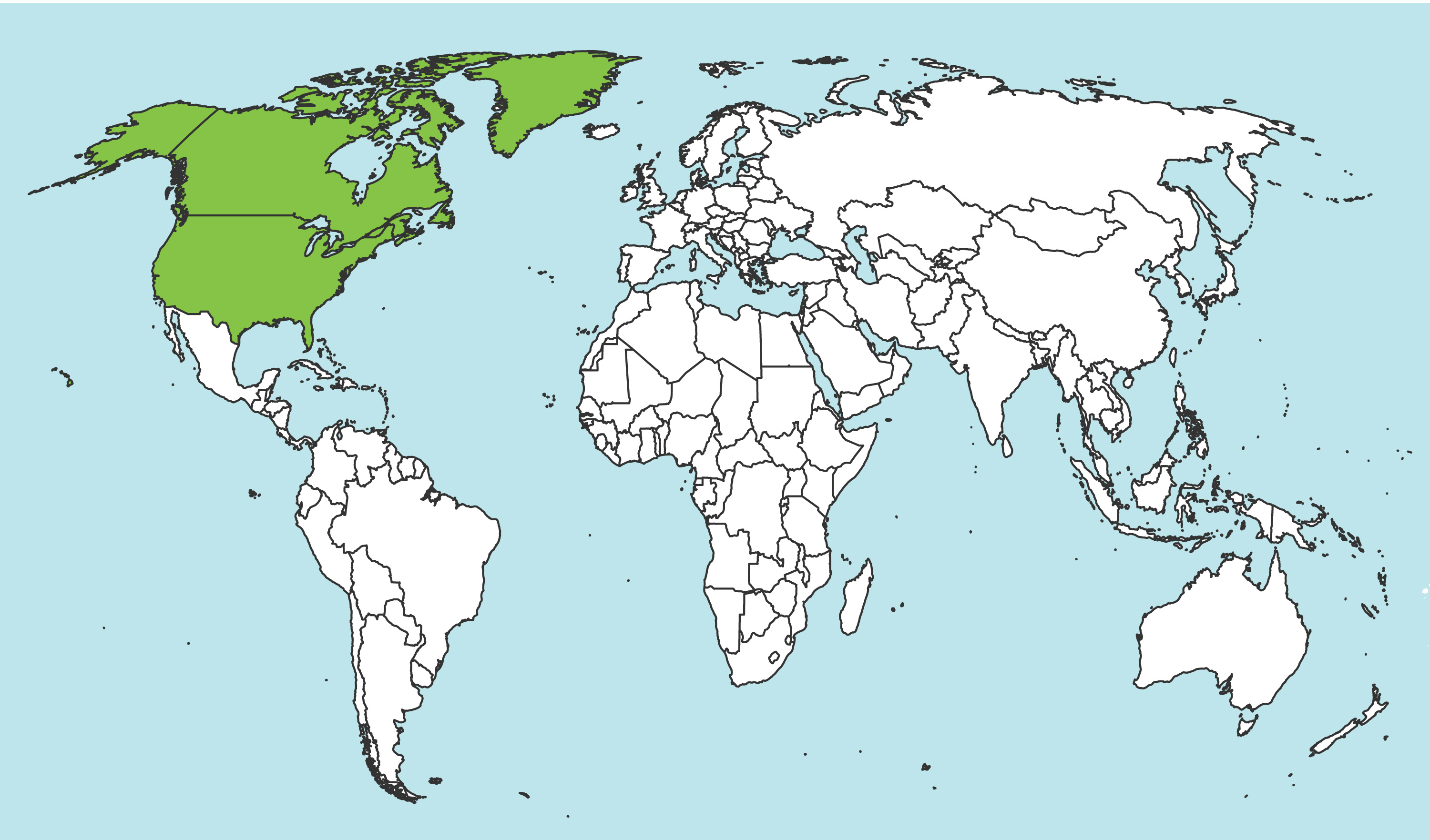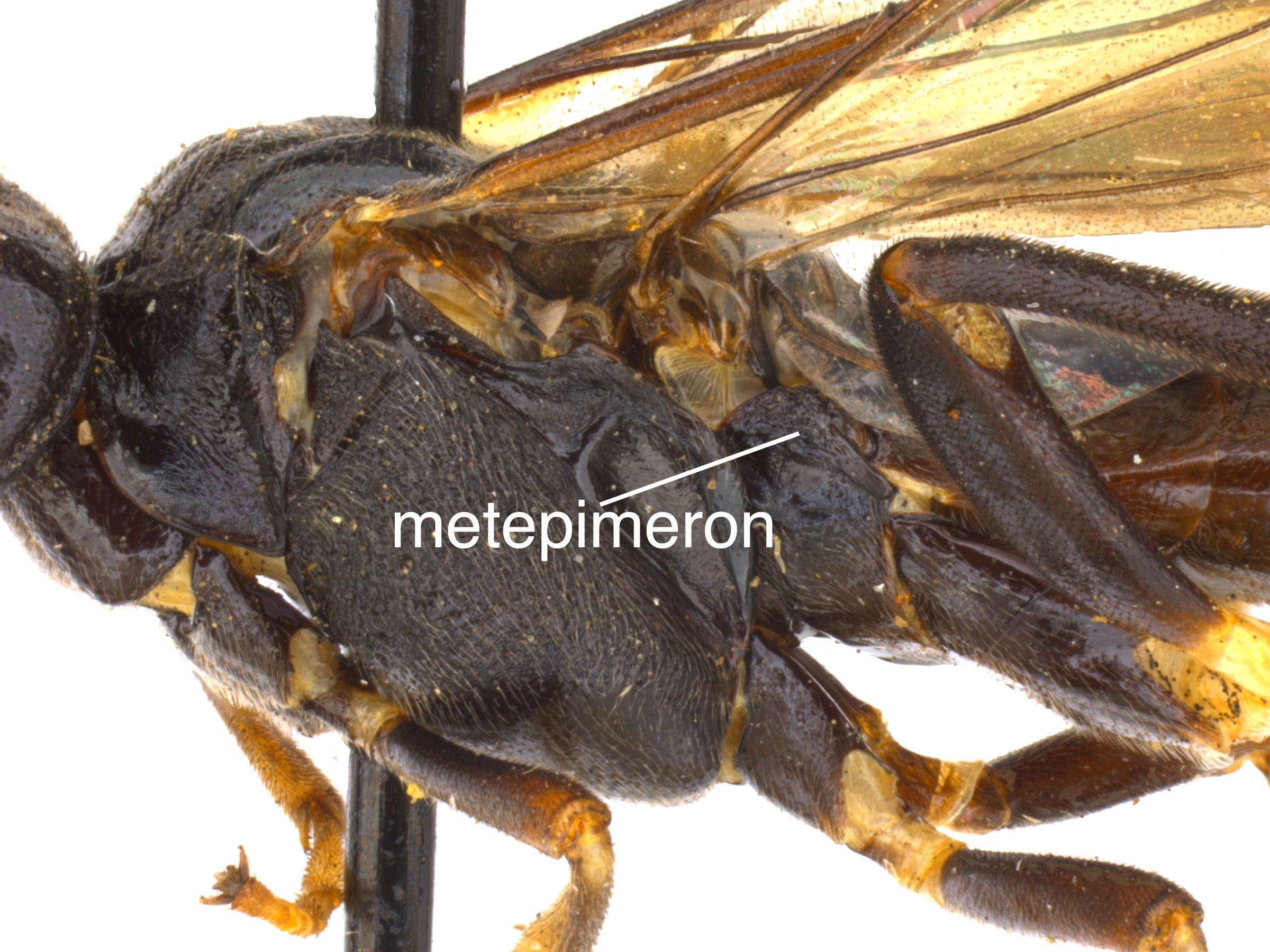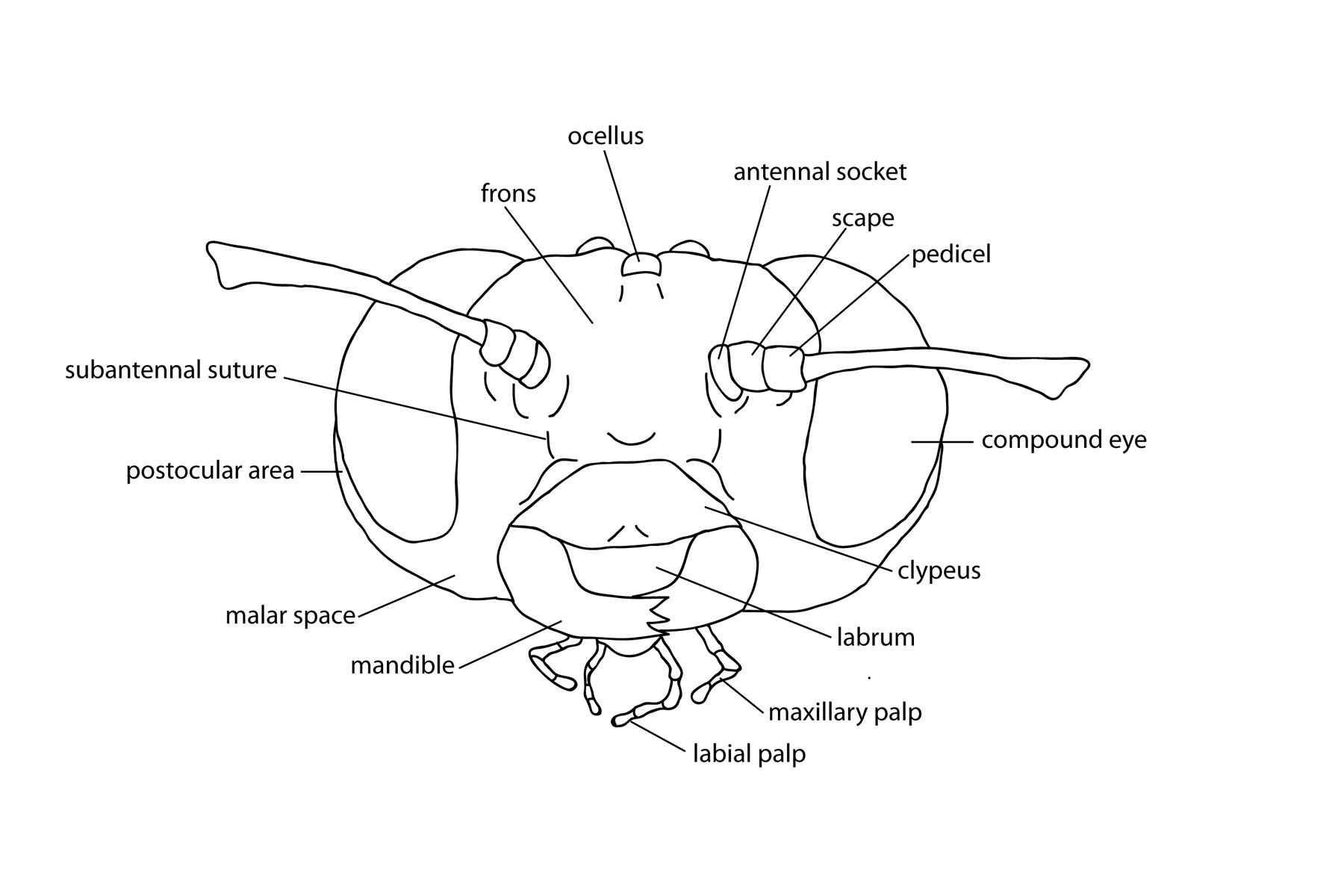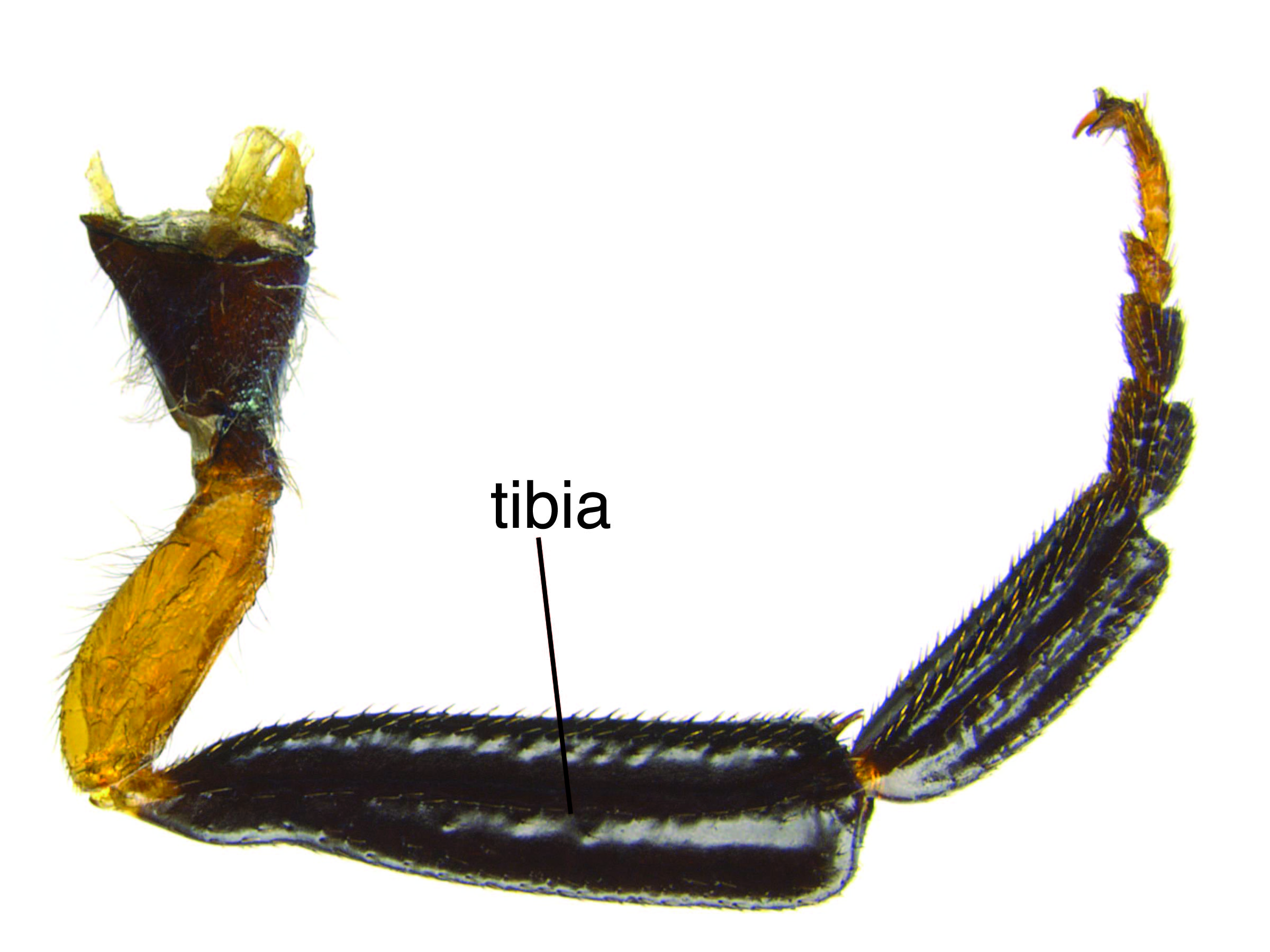Family: Argidae
Family common name: argid sawflies
Subfamily: Sterictiphorinae
Genus: Ptenos Norton, 1872
Subgenera: none
Argidae are found in all non-polar regions of the world (Smith and Middlekauff 1987Smith and Middlekauff 1987:
Smith DR and Middlekauff WW. 1987. Suborder Symphyta. In: Stehr FW ed. Immature Insects. Kendall/Hunt Publishing Company. Vol. 1: 754 pp., Smith 1992Smith 1992:
Smith DR. 1992. A synopsis of the sawflies (Hymenoptera: Symphyta) of America south of the United States: Argidae. Memoirs of the American Entomological Society 39: 1-201.). They are external foliage feeders with a wide range of host plants. Additionally, the family exhibits some uncommon behaviors like the excretion of defensive compounds and subsocialsubsocial:
Living in aggregations but lacking organizational structure as in true social insects; can describes insects with tendencies to protect or care for thier young, feed gregariously, and build cocoon masses.
habits (Smith 1992Smith 1992:
Smith DR. 1992. A synopsis of the sawflies (Hymenoptera: Symphyta) of America south of the United States: Argidae. Memoirs of the American Entomological Society 39: 1-201.).
Ptenos are about 6–8 mm in length, and in North America are generally red and black in color. They are recognized by wing venationvenation:
the network of veins on a wing
, large eyes, and characteristic 3-segmented antennaeantenna:
the sensory organ emerging from the front of the head, usually between the compound eyes and above the clypeus; includes the flagellum, scape and pedicel
 , which in males are distinctly forked, and in females are slightly curled (Smith 1971cSmith 1971c:
, which in males are distinctly forked, and in females are slightly curled (Smith 1971cSmith 1971c:
Smith DR. 1971c. Nearctic sawflies of the genera Neoptilia Ashmead, Schizocerella Forsius, Aprosthema Konow, and Sphacophilus Provancher (Hymenoptera: Argidae). Transactions of the American Entomological Society 97: 537-594., Smith 1992Smith 1992:
Smith DR. 1992. A synopsis of the sawflies (Hymenoptera: Symphyta) of America south of the United States: Argidae. Memoirs of the American Entomological Society 39: 1-201., Vikberg 2004Vikberg 2004:
Vikberg V. 2004. Seasonal head dimorphism and taxonomy of some European species of Aprosthema (Hymenoptera: Symphyta: Argidae). Beitrauml;ge Zur Entomologie 54 (1): 107-125. https://doi.org/10.21248/contrib.entomol.54.1.107-125).
There are 31 species described worldwide, all restricted to the Americas. Eleven species occur in North America (Smith 1992Smith 1992:
Smith DR. 1992. A synopsis of the sawflies (Hymenoptera: Symphyta) of America south of the United States: Argidae. Memoirs of the American Entomological Society 39: 1-201., Taeger et al. 2010Taeger et al. 2010:
Taeger A, Blank SM, and Liston AD. 2010. World Catalog of Symphyta (Hymenoptera). Zootaxa 2580: 1-1064.).
A key to NearcticNearctic:
describing the region of the Northern Hemisphere that includes North America south through northern Mexico
 species of Ptenos (as Ptenus) is included in Smith 1970Smith 1970:
species of Ptenos (as Ptenus) is included in Smith 1970Smith 1970:
Smith DR. 1970. Nearctic species of the genus Ptenus Kirby (Hymenoptera: Argidae). Transactions of the American Entomological Society 96: 79-100..
 (Smith 1992Smith 1992:
(Smith 1992Smith 1992: less than width of cenchruscenchrus:
less than width of cenchruscenchrus: (Smith 1992Smith 1992:
(Smith 1992Smith 1992: fused laterally with first tergitetergite:
fused laterally with first tergitetergite: (Smith 1992Smith 1992:
(Smith 1992Smith 1992: R closed at apexapex:
R closed at apexapex: often slightly to moderately laterally expanded (Smith 1992Smith 1992:
often slightly to moderately laterally expanded (Smith 1992Smith 1992: simple (Smith 1992Smith 1992:
simple (Smith 1992Smith 1992: tapering and slightly curled (Smith 1992Smith 1992:
tapering and slightly curled (Smith 1992Smith 1992:The family Argidae can be distinguished by the single-segmented flagellumflagellum:
the third section of the antennae that includes all the segments beyond the pedicel; segments of the flagellum are known as flagellomeres
 of the antennaantenna:
of the antennaantenna:
the sensory organ emerging from the front of the head, usually between the compound eyes and above the clypeus; includes the flagellum, scape and pedicel
 . The genus Ptenos can be distinguished from other genera in the family by the lack of preapicalpreapical:
. The genus Ptenos can be distinguished from other genera in the family by the lack of preapicalpreapical:
close to, but anterior to, the apex
 spurs on the tibiaetibia:
spurs on the tibiaetibia:
the fourth segment of the leg, between the femur and the tarsus
 , the simple tarsal claws and a lack of veinvein:
, the simple tarsal claws and a lack of veinvein:
a tube-like, often darkened, structure on the wings
 Sc in the fore wingfore wing:
Sc in the fore wingfore wing:
the anterior wing of each pair of wings; usually the largest wing of the pair
 . Males are distinguished from related genera Arge and Atomacera by the conspicuous forked antennaeantenna:
. Males are distinguished from related genera Arge and Atomacera by the conspicuous forked antennaeantenna:
the sensory organ emerging from the front of the head, usually between the compound eyes and above the clypeus; includes the flagellum, scape and pedicel
 (Smith 1992Smith 1992:
(Smith 1992Smith 1992:
Smith DR. 1992. A synopsis of the sawflies (Hymenoptera: Symphyta) of America south of the United States: Argidae. Memoirs of the American Entomological Society 39: 1-201.).
none
No hosts are known for Ptenos. One specimen of P. leucopoda is recorded feeding on “Inya sp.” which might be a misspelling of Inga (Fabaceae) (Smith 1992Smith 1992:
Smith DR. 1992. A synopsis of the sawflies (Hymenoptera: Symphyta) of America south of the United States: Argidae. Memoirs of the American Entomological Society 39: 1-201.).
Larvae and life histories are unknown for Ptenos species (Smith and Middlekauff 1987Smith and Middlekauff 1987:
Smith DR and Middlekauff WW. 1987. Suborder Symphyta. In: Stehr FW ed. Immature Insects. Kendall/Hunt Publishing Company. Vol. 1: 754 pp.).
World: This genus ranges in North and South America, from as far north as the United States, as far south as Argentina (Smith 1992Smith 1992:
Smith DR. 1992. A synopsis of the sawflies (Hymenoptera: Symphyta) of America south of the United States: Argidae. Memoirs of the American Entomological Society 39: 1-201.).
North America: Ptenos ranges throughout Mexico and Central America. Two species, P. dominicaensis and P. thoracicus, are only recorded from the West Indies, in the countries of Dominica and Grenada respectively. Two species occur in the United States: P. texanus known from Mexico north into Texas, and P. vanus known from northern Mexico into Arizona and New Mexico (Smith 1992Smith 1992:
Smith DR. 1992. A synopsis of the sawflies (Hymenoptera: Symphyta) of America south of the United States: Argidae. Memoirs of the American Entomological Society 39: 1-201.).
Map data from: GBIF.org (26 June 2019) GBIF Occurrence Download Ptenos
Details about data used for maps can be found here.